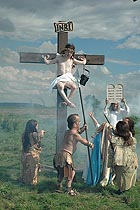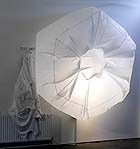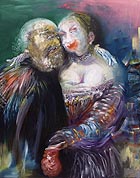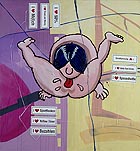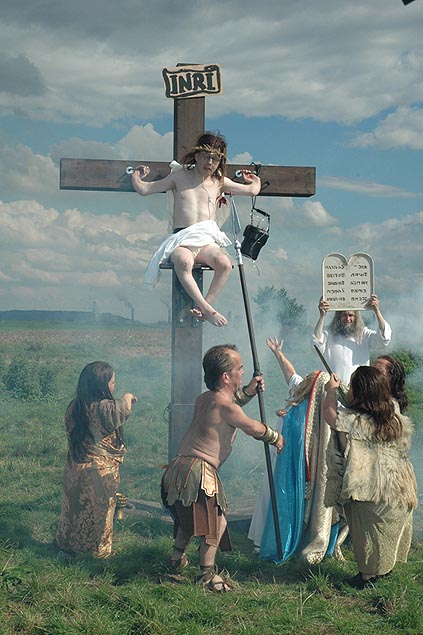
translated and summarized by: Liz Wollner-Grandville,
English summary June 19 - July 3
CharimGalerie: Christoph Schlingensief
Jesus on the drip
“Fear is power! Fear is our trigger! No leader, no God will lead you” – this is the ‘Church of Fear’s’ credo. The artist Christoph Schlingensief founded the ‘Church of Fear’ in 2003 during the 50th Venice Biennale; in the meantime it has more than 100 member communities. A miniature edition of the Caribbean-style church is for sale for 10.000 euros and is one of the objects presented at the exhibit in Vienna. A large part of Schlingensief’s display at the CharimGalerie is unusually market conformist, except for the installation “Little Shrine”, which shows videos of Lady Di’s and Dodi Al Fayed’s last hours, reconstructed as a kind of actionist bout.
Schlingensief displays photographs, which are based on some of his former projects, among them the photo series “Horror-house Holmur”, or the house of “not administrable obsessions” on Iceland, where the famous “Animotograph” was employed for the first time. The Passion (of the Christ) is performed by disabled people and based on the opera “Freaks”. At first the large-scale presentation of these pictures makes them seem bold and cynical. Jesus is on the cross and on the drip, surrounded by Lilliputians. Schlingensief’s answer would be: in any case political correctness is factitious.
The centrepiece of the exhibit is the arrangement “The king lives inside of me”. The film, which was shot in Nepal, is presented in six open fireplaces with photos placed over them in light boxes. Depictions of the evisceration of slaughtered animals, a Hindu cremation, a sleeping mendicant, an aging Nepalese waving and smiling into the camera, views of a surgery, and of Schlingensief wearing a white colonial ruler’s suit in the midst of Nepalese brick workers, constitute the images of the installation. The dominating topics encompass religions and rituals, exploitation, as well as sickness and death. Despite the cosy open fireplaces, Schlingensief’s work remains to be what it always has been: uncomfortable.
CharimGalerie
1010 Vienna, Dorotheergasse 12, until 31. 07. 08
www.charimgalerie.at
MAK-Ausstellungshalle: The Essence 08 – Annual exhibit of the University of Applied Arts
Complex essences
As the son of the director of the University of Applied Arts and as someone whose work is presented at the University’s annual exhibit “The Essence”, you will naturally be scrutinized. But Lukas Basts’s project deservedly attracts attention: his invention “measuring device for status bound and dynamic snow conditions" (Messgerät für zustandsgebundene und dynamische Schneeverhältnisse ) designed in Paolo Piva’s Industrial Design course, unites a complex and, until now, decentralized measuring system, into one single apparatus.
The majority of the works displayed at this exhibit - curated by Edek Bartz - focus on the topic of complex realities. Designed as an ‘exhibit within the exhibit’, Agnes Steiner, Malin Schoenberg, and Tobias Egger enable the Institute of Design and Graphics to repeatedly position itself in the midst of the other presentations. Visitors are meant to distribute the sapphire blue pellets constituting border markings on the floor throughout the entire space of the exhibit.
Nina Kataeva’s installation C(R)ASH is linked (via Internet) to the New York stock exchange. A huge airbag is reinflated every time the investors fear that the stock market will crash – until the bubble blasts.
Günther Seyfried’s “Mutants from Innerspace” encodes a film scene of a single DNA strand, which in turn is synthesised into a double helix. The mutations caused by ultraviolet radiation are then again transformed into a film scene. Integrating coincidence into artwork represents a definitely contemporary concept.
The sculpture “Anna” by Florian Hafele draws a lot of attention, but it is so obviously the work of one of Erwin Wurm’s students that it is unable to develop its own language. Claudia Larcher’s video installation “Heim” (home), however, has clearly found its own language. A selection of photographs combined with a few video scenes leads the onlooker through her parental home. The film’s realism is superimposed by an indefinable uneasiness, which disquiets the onlooker, but remains intangible.
MAK Ausstellungshalle
1010 Vienna, Weiskirchnerstrasse 3, until 13. 07. 08
Exhibition documentation
Galerie Thaddaeus Ropac: Bernhard Martin - God and I already know
Perfect Bad Painting
Bernhard Martin’s paintings would have fit perfectly to the “Bad Painting” exhibit currently shown at the MUMOK (see this week's English summaries). But it remains unclear if his paintings should be considered as kitsch or more “I-paint-carelessly-on-purpose”. On the one hand he chooses rather kitschy motifs: spaghetti rolled onto a fork, bright-pink moths flying towards a blazing light or cute little villages. On the other hand he transforms faces and bodies into wild, sometimes even psychedelic masses of colour. In surreal scenes bodies meet with globes instead of heads in eerie office-settings, small houses are hurled through clouds, masked people flee from their look-alikes, a man with a butterfly in his mouth sits in front of a dark window, a ghost staring at him. Martin continuously refers to art history, proving that having studied in Leipzig is not a prerequisite for this kind of art. Something that does, however, distinguish him from his Leipzig colleagues, is his ironical approach, sometimes reminding of Martin Kippenberger; and he also lacks Matthias Weischer’s delicate style of painting – something that makes him likeable. However, why an artist who paints such madcap, gloomy pictures, is considered to be a “chronicler of everyday life”, as he is described in the Ropac Gallery press release, remains a mystery – just like his work.
Galerie Thaddaeus Ropac
5020 Salzburg, Mirabellplatz 2, until 12. 07. 08
www.ropac.net
MUMOK Museum moderner Kunst: Bad Painting – Good Art
Trendy-kitschy-trashy
Unfortunately bad art no longer exists. There are plenty of bad paintings around, but if they were actually labelled as such, commissions would immediately be put into place to establish ‘that quality is practically everywhere’. Art can never fail, “and if the risk of failing isn’t there, then it becomes an ornament” said the sociologist Ulrich Oevermann.
“Bad Painting – Good Art”, the title of the current MUMOK exhibit - where plenty of this “ornament” is displayed - defines this mechanism in a nutshell. Thanks to this mechanism it is secondary to contemplate if bad art was intentionally submitted for the exhibit. This may be the case with the unholy Trinity Picabia-Polke-Kippenberger as well as with John Currin - they all displayed their work at the Kunsthalle in 2003 for the “Lieber Maler, male mir” presentation.
But the extensive historical part of the exhibit also presents artists like Asger Jorn, whose salon paintings clearly represent a positive effort. Ugliness must be distinguished from bad quality, and the English word “bad” allows for manifold connotations. De Chirico shows classical figures implying fellatio, Magritte positions his trademark, the pipe, a dozen times into the face of a bearded man, and Philip Guston is once again presented with one of his late works. All of this is somewhat off the mark and rather trendy-kitschy-trashy.
It is therefore important to fulfil the last criteria, which still has some validity. Albert Oehlen’s invokes this with his painting titled “Sammlung Essl” (1982). The Klosterneuburg-collection is famous for its rigid payment modalities, whereby many artists are forced to vend their non-sellers. The “lemon cars” of the art world are parked on the banks of the Danube. Parking there is one of the risks that remain.
MUMOK Museum moderner Kunst
1070 Vienna, Museumsquartier, until 12. 10. 08
www.mumok.at
Mehr Texte von translated and summarized by: Liz Wollner-Grandville


 Teilen
Teilen

